Ingredients for Web Accessibility: A Step-Through Overview
[@@introduction@@ Much of the focus of Web accessibility has been on the
responsibilities of Web content developers. This view misses the crucial
interdependence of other "ingredients" of Web development and
interaction.]
This overview introduces how the different ingredients each have a role in
Web accessibility, and the WAI guidelines for the different ingredients.
See also:
About Ingredients for Web
Accessibility Step-Through Overview
includes instructions for using this material.
Web Content
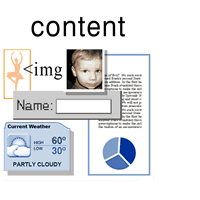
Web content is the information in a Web
page or Web application,
including text, images, forms, sounds, and such.
Getting Web Content
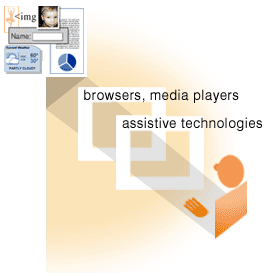
People ("users")
use
Web browsers, media players,
assistive technologies, and other "user agents"
to get and interact with Web content.
Making Web Content
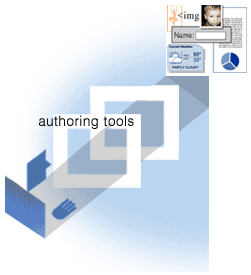
Web content developers
use authoring tools and evaluation
tools
to create Web content. (@@update iamges)
Ingredients for Web Accessibility
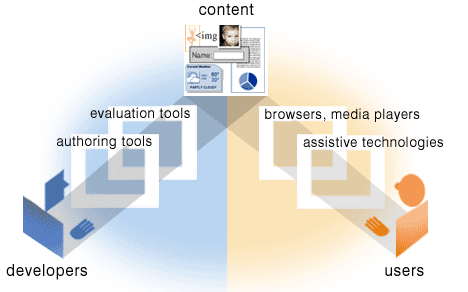
Next, let's take a closer look at each ingredient
along with an example, alternative text equivalents or
"alt text"
Alt Text in Web Content


<img alt="Web Accessibility Initiative logo"... />
- What is alt text?
- Alt text for an image provides the same functional information in
text as the image provides visually. That is, whatever meaning the
image conveys visually, the alt text conveys in text. Alt text is
read by screen readers and voicing browsers (which are used by people
who are blind and people who cannot read), displayed in text browsers
in place of the image, and displayed in graphical browsers when
images are not downloaded.
- Remember that Web content is the information in a Web
site, including text, images, forms, sounds, and such. It also includes
"markup" or Web code.
- Alt text example: Web content needs to include the alt text in the
markup, along with the image.
Getting Web Content
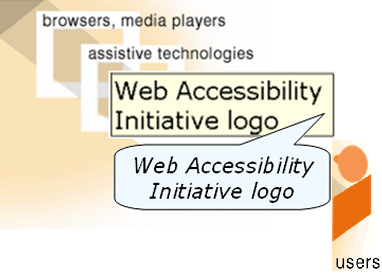
- Web browsers, media players, and other "user
agents" are software that you use to get and interact with
Web content
- Alt text example: User agents need to provide the alt text to
users, e.g., graphical browsers display the alt text when the user
turns off images
- Assistive
technologies are software and hardware that people with
disabilities use to interact with the Web, such as screen readers,
alternative keyboards, switches, and scanning software, and such
- Alt text example: Assistive technologies need to provide the alt
text to users, e.g., screen readers read the alt text
- Users' knowledge, skill, and strategies for using the
Web are an ingredient in Web accessibility
- Alt text example: Users need to know how to get the alt text from
their user agent and assistive technology as needed
Making Web Content
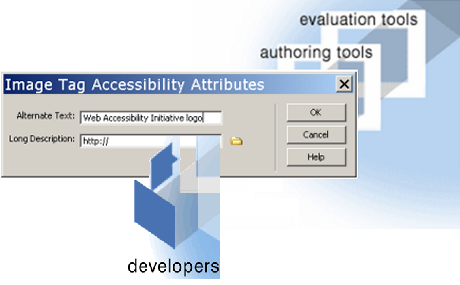
- Content developers are content producers, designers,
coders, authors, and such, including developers with disabilities and
users who contribute content to the Web
- Alt text example: Content developers need to provide the
appropriate alt text wording in the markup
- Authoring
tools are software to create and modify Web sites, including
Web page editors, Word processors that save files in web formats, content
managements systems (CMS), and Web sites that let users add content, such
as blogs, wikis, and photo-sharing sites
- Alt text example: Authoring tools need to enable, facilitate, and
promote providing alt text in a Web page, e.g., when the content
developer puts an image on a page, the authoring tool prompts for alt
text
- Evaluation tools help determine if a Web site is
accessible, and include Web accessibility evaluation tools, HTML
validators, and CSS validators
- Alt text example: Web accessibility evaluation tools need to check
that alt text exists, and help check that it is equivalent
Ingredients for Web Accessibility

Question: How do you know who is suppose
to do what for Web accessibility?
Answer: W3C WAI Accessibility Guidelines...
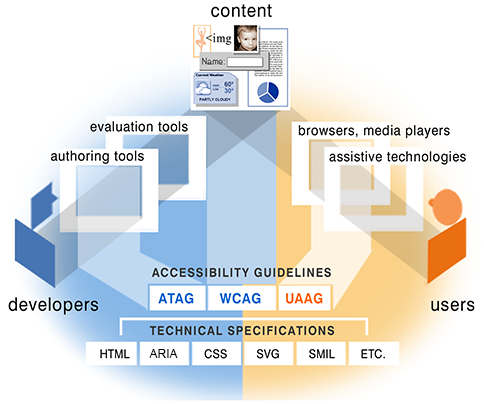
For More Information
Version: DRAFT $Date: 2006/09/13 00:30:00 $
Editor: Shawn Lawton
Henry. Graphic artist: Michael Duffy.
Developed with the Education and Outreach Working Group (EOWG).
[Contacting WAI] Feedback welcome to
wai-eo-editors@w3.org.





































